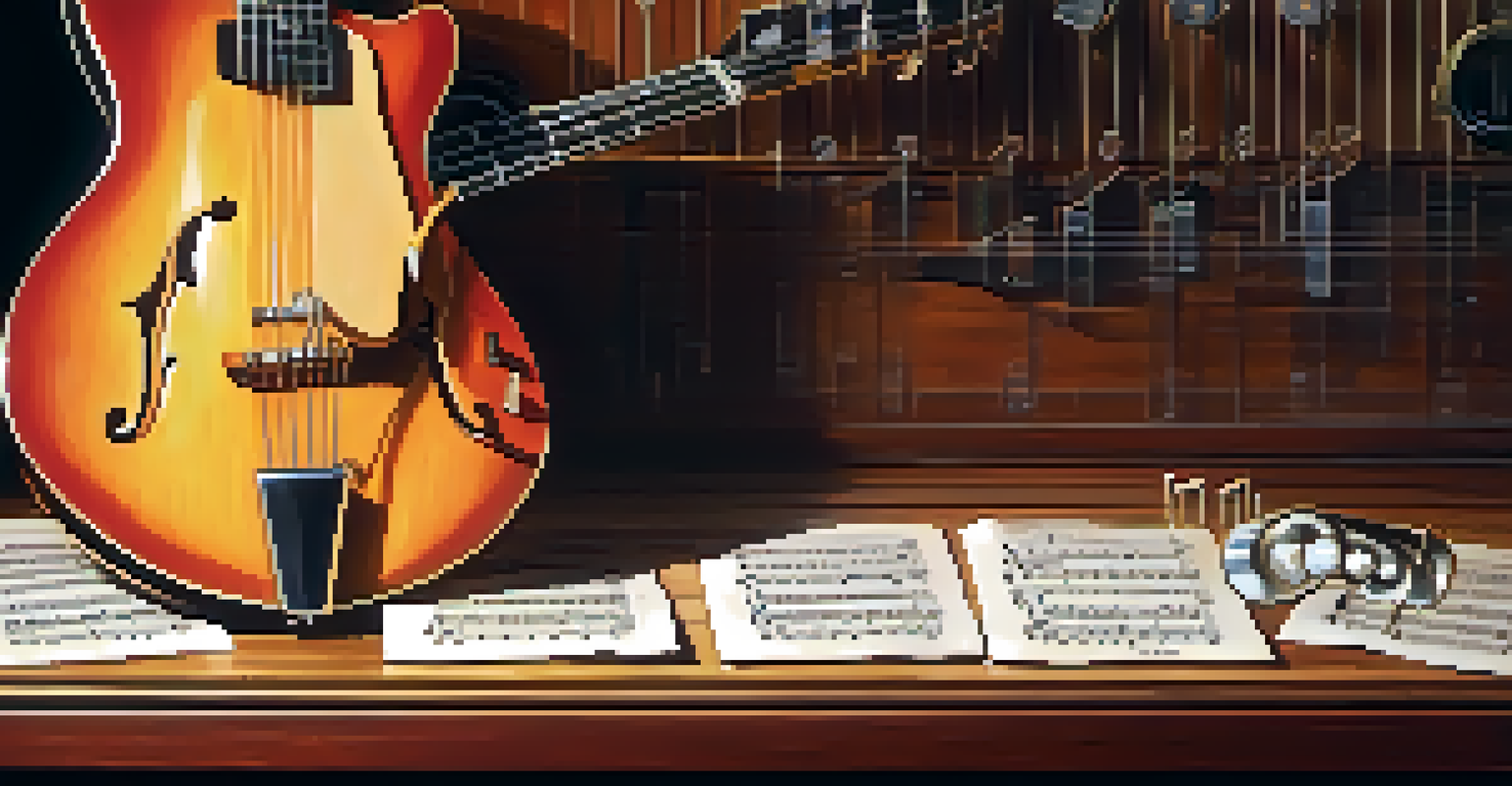How to Construct and Use Major and Minor Chord Extensions

Understanding Chord Extensions: A Musical Foundation
Chord extensions enrich the harmonic palette of music, allowing for more intricate sounds. Essentially, they involve adding notes to basic chords, creating layers that evoke emotion and depth. For example, a basic C major chord consists of C, E, and G, but adding a D note transforms it into a Cmaj7, giving it a jazzier feel.
Music can change the world because it can change people.
To grasp chord extensions, it’s important to understand the basic structure of major and minor chords. Major chords are built from the root, major third, and perfect fifth, while minor chords replace the major third with a minor third. This foundational knowledge is crucial before diving into extensions, as it allows musicians to visualize and hear the differences more clearly.
Once you’re comfortable with basic chords, imagine them as a canvas. Chord extensions are like the brush strokes that add depth and texture, making your musical painting more vibrant and interesting. The beauty of chord extensions lies in their ability to evoke different feelings, from tension to resolution, enhancing your overall composition.
Constructing Major Chord Extensions: Step by Step
To construct major chord extensions, start by identifying the root chord, then add notes based on the scale. For instance, with a C major chord, you can add the seventh note (B) to create a Cmaj7. If you want to take it further, you can add the ninth (D), creating a Cmaj9, which adds even more color to your sound.

Another popular extension is the major sixth, which involves adding the sixth note from the scale. For C major, this would be A, resulting in a C6 chord that has a warm, uplifting quality. Experimenting with these extensions can transform your compositions, giving them a fresh vibe and keeping your listeners engaged.
Chord Extensions Enhance Emotion
Adding notes to basic chords creates layers that evoke deeper emotional responses in music.
As you play around with these extensions, think about how they can serve your song’s emotional arc. Major chord extensions often convey positivity and brightness, so consider where they fit best in your piece. Using them thoughtfully can create moments of joy and resolution that resonate with your audience.
Exploring Minor Chord Extensions: A Creative Approach
Minor chord extensions also offer exciting possibilities for expanding your sound. Start by taking a basic minor chord, like A minor (A, C, E), and consider adding the seventh note (G) to create an Am7. This simple addition deepens the chord's emotional impact, making it feel more complex and engaging.
The beautiful thing about music is that it connects people. It carries a message, and we can all hear it.
You can also explore adding the ninth (B) to form an Am9, or the sixth (F) for an Am6, each bringing its own unique flavor. These extensions can make your music feel more introspective, allowing for a richer storytelling experience through harmonies. Think of them as adding layers to a character in a novel; each layer reveals something new.
When incorporating minor chord extensions, be mindful of their emotional weight. Minor chords often evoke feelings of sadness or longing, so using extensions can amplify these sentiments. This can create beautiful contrasts within your music, leading to moments of tension followed by resolution, captivating your listeners in a profound way.
Practical Applications for Chord Extensions in Songwriting
When writing songs, incorporating major and minor chord extensions can elevate your work from good to great. Use them to create tension and release, guiding your listeners through the emotional landscape of your music. For example, transitioning from a simple C major to a Cmaj7 before resolving to an A minor can create a poignant moment that resonates deeply.
Think about the genre you're working in as you explore these extensions. Jazz and R&B often rely heavily on rich chord extensions, while pop may use them more sparingly for emphasis. Tailoring your use of extensions to your style can help you create a unique sound that stands out.
Practical Use in Songwriting
Incorporating chord extensions can elevate songwriting by guiding listeners through emotional landscapes.
Additionally, don’t hesitate to experiment! Try different combinations of major and minor extensions within your chord progressions. Play with their order and timing, allowing intuition to guide you. This exploration can lead to unexpected discoveries that enhance your songwriting process.
Using Chord Extensions in Improvisation and Performance
Chord extensions aren’t just for songwriting; they’re also powerful tools for improvisation and live performance. When jamming with other musicians, incorporating extensions can add complexity and interest to your playing. For instance, while playing a standard progression, try inserting a Cmaj7 or Am9 to surprise your fellow musicians and keep the energy high.
In improvisation, think of chord extensions as opportunities for expression. Adding a 9th or 13th can create a lush sound that invites your audience to feel the music on a deeper level. Remember to listen to the context of the piece; extensions should enhance the overall vibe rather than overwhelm it.
Practicing improvisation with chord extensions can also help you build confidence in your playing. Start slowly, adding one extension at a time, and notice how it changes the feel of the music. As you become more comfortable, you’ll find it easier to weave these extensions into your solos and performances seamlessly.
Analyzing Popular Songs with Chord Extensions
One of the best ways to understand the use of chord extensions is by analyzing popular songs. Many well-known tracks incorporate major and minor extensions to create memorable hooks and emotional moments. For instance, songs like 'The Way You Make Me Feel' by Michael Jackson prominently feature major seventh chords, enhancing their upbeat feel.
Listening closely to how these extensions are woven into the fabric of a song can provide valuable insights. Notice how artists transition between basic chords and their extensions, paying attention to the emotional shifts that occur. This can inspire you to incorporate similar techniques into your own music.
Improvisation with Chord Extensions
Using chord extensions during improvisation adds complexity and richness to live performances.
Taking time to dissect your favorite songs will not only improve your ear but also deepen your understanding of harmony. You’ll start to recognize patterns and common practices, helping you to apply these insights when constructing your own chord progressions with extensions.
Final Thoughts on Chord Extensions in Music Composition
Chord extensions are more than just technicalities; they are creative tools that can transform your music. By understanding how to construct and utilize these extensions, you gain the ability to convey a wider range of emotions and complex ideas. Remember, the journey of exploration is just as important as the end result.
As you continue to practice and apply these concepts, stay open to the possibilities they present. Whether you're writing a new song, performing live, or simply jamming with friends, chord extensions can enhance your musical expression. They allow you to paint your soundscape with richer colors, inviting your audience into the story you want to tell.

In the end, don’t be afraid to make mistakes along the way. Each chord you play, each extension you try, adds to your musical journey. Embrace the learning process, and most importantly, have fun as you explore the vast world of chord extensions in music!